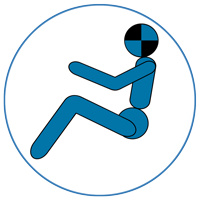This title includes the technical papers developed for the 2023 Stapp Car Crash Conference, the premier forum for the presentation of research in impact biomechanics, human injury tolerance, and related fields, advancing the knowledge of land-vehicle crash injury protection.
Topics covered in this issue include:
- Automobile accidents, crash scenarios, injury biomechanics, occupant kinematics
- Finite element models, simulations, human body models
- Head injury metrics, injury biomechanics
Purchase Vol. 67 through SAE (Print | Digital)
-
Comparison of Adult Female and Male PMHS Pelvis and Lumbar Response to Underbody Blast Authors: Hollie Pietsch—US Army DEVCOM Ground Vehicle Systems Center, Wayne State University; Danielle Cristino, Matthew Mason, Andrew Kemper, and Warren Hardy—Virginia Tech, Center for Injury Biomechanics; Kerry Danelson—Wake Forest School of Medicine, Department of Orthopedic Surgery; John Bolte IV —The Ohio State University; John Cavanaugh—Wayne State University, Department of Biomedical Engineering (Retired) Abstract The goal of this study was to gather and compare kinematic response and injury data on both…
-
Machine-Learning-Accelerated Simulations for the Design of Airbag Constrained by Obstacles at Rest Authors: José E. Valenzuela del Río, Elena Arvanitis, and Lucia Mirabella—Siemens Technology, United States; Richard Lancashire, Karan Chatrath, and Peter Ritmeijer—Siemens Industry Software, Netherlands Abstract Predicting airbag deployment geometries is an important task for airbag and vehicle designers to meet safety standards based on biomechanical injury risk functions. This prediction is also an extraordinarily complex problem given the number of disciplines and their interactions. State-of-the-art airbag deployment geometry simulations (including…
-
Examination of Crash Injury Risk as a Function of Occupant Demographics Authors: Dainius Dalmotas, Aline Chouinard, Jean-Louis Comeau, Alan German, Glenn Robbins—D.J. Dalmotas Consulting, Inc.; Priya Prasad—Prasad Engineering, Inc. Abstract The objectives of this study were to provide insights on how injury risk is influenced by occupant demographics such as sex, age, and size; and to quantify differences within the context of commonly-occurring real-world crashes. The analyses were confined to either single-event collisions or collisions that were judged to be well-defined…
-
Evaluation of DAMAGE Algorithm in Frontal Crashes Authors: Priya Prasad—Prasad Engineering, Inc.; Saeed D. Barbat and Anil Kalra—Ford Motor Company; Dainius Dalmotas—D.J. Dalmotas Consulting, Inc. Abstract With the current trend of including the evaluation of the risk of brain injuries in vehicle crashes due to rotational kinematics of the head, two injury criteria have been introduced since 2013 – BrIC and DAMAGE. BrIC was developed by NHTSA in 2013 and was suggested for inclusion in the US…
-
Standardized Assessment of Gravity Settling Human Body Models for Virtual Testing Authors: B. Wade von Kleeck, Juliette Caffrey, Ashley A. Weaver, and F. Scott Gayzik—Biomedical Engineering, Wake Forest University School of Medicine; Jason Hallman—Toyota Motor North America R&D Abstract The increased use of computational human models in evaluation of safety systems demands greater attention to best practices in coupling the model to its seated environment. This study assessed the THUMS v4.0.1 in an upright driver posture and a reclined occupant posture….
-
Investigation of THOR-AV 5F Biofidelity in Sled Test Conditions with A Semi-Rigid Seat Authors: Z. Jerry Wang—Humanetics Innovative Solutions, Inc.; John Humm and Hans W. Hauschild—Medical College of Wisconsin Abstract THOR-AV 5F, a modified THOR-5F dummy, was designed to represent both upright and reclined occupants in vehicle crashworthiness studies. The dummy was evaluated in four test conditions: a) 25° seatback, 15 km/h, b) 25° seatback, 32 km/h, c) 45° seatback, 15 km/h, d) 45° seatback, 32 km/h. The dummy's biomechanical responses were compared…
-
Frontal-Crash Occupant Protection in the Rear Seat: Submarining and Abdomen/Pelvis Response in Midsized Male Surrogates Authors: Allison J. Guettler, Samuel T. Bianco, Devon L. Albert, David M. Boyle, Andrew R. Kemper, and Warren N. Hardy—Virginia Tech, Center for Injury Biomechanics Abstract Frontal-crash sled tests were conducted to assess submarining protection and abdominal injury risk for midsized male occupants in the rear seat of modern vehicles. Twelve sled tests were conducted in four rear-seat vehicle-bucks with twelve post-mortem human surrogates (PMHS). Select kinematic responses and submarining…
-
Driving Behavior during Left-Turn Maneuvers at Intersections on Left-Hand Traffic Roads Author: Yasuhiro Matsui and Masashi Narita—National Traffic Safety and Environment Laboratory, Japan; Shoko Oikawa—Tokyo Metropolitan University, Japan Abstract Understanding left-turn vehicle-pedestrian accident mechanisms is critical for developing accident-prevention systems. This study aims to clarify the features of driver behavior focusing on drivers' gaze, vehicle speed, and time to collision (TTC) during left turns at intersections on left-hand traffic roads. Herein, experiments with a sedan and light-duty truck (< 7.5 tons…
